For photos, please click here.
For speech, please click here.
For Mr Li Ka-shing's Q&As in the in-house magazine of the Stanford University School of Medicine, please click here.
 |
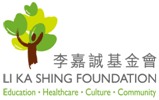 |
transforms medical training at Stanford University
(Palo Alto, 29 September 2010) The Stanford University School of Medicine today begins a new era with the dedication of the Li Ka Shing Center for Learning and Knowledge, expected to dramatically change the way in which physicians are trained.
The five-story building with a diverse array of sophisticated technologies - including one of the largest and most advanced simulation facilities in the country and a high-end video capture system - represents the latest in medical education. It is designed for interactive, experiential and team-based approaches to learning for people at all levels, from incoming medical students to experienced clinicians.
Speaking at today's dedication ceremony, University President John Hennessy said, "The Li Ka Shing Center for Learning and Knowledge exemplifies the future of medical education. Positioned in the center of the Stanford University School of Medicine, the LKSC builds on our strengths in the biomedical sciences and related disciplines. Its use of cutting-edge technology advances a new model for educating doctors and scientists in this century and will allow us to make even greater contributions to society. We owe a special thanks to Mr Li Ka-shing for his visionary philanthropy, as well as to the many other donors whose generosity has made this building possible."
Hong Kong entrepreneur and global philanthropist Li Ka-shing, a long-time friend of Stanford, is the building's major benefactor. He was attracted to the project because of his continuing relationship with the university and its dedication to the highest standards and innovation in health care sciences, as well as his belief that the new center will contribute to transformative change in medicine through leading-edge education that reaches beyond traditional health care training to include knowledge and learning from many other disciplines.
"Stanford has a proud and honored history in medical education, research, and delivery," Mr Li said today. "This new center opens an exciting and even futuristic multi-dimensional learning experience by creating a synergy of interdisciplinary programs to provide virtual training and tools for students and practitioners to receive the best information and knowledge across an infinite array of academic platforms. There is nothing like it in the world, and we are pleased to be a part of this historic day."
Mr Li, who traveled from Hong Kong for the building's dedication, is the Chairman of Cheung Kong (Holdings) Limited and Hutchison Whampoa Limited, two of Asia's most prominent companies, with about 240,000 employees in 54 countries.
He is also Chairman of the Li Ka Shing Foundation and has pledged one-third of his assets to philanthropy. To date, Mr Li has granted more than US$1.45 billion to projects worldwide, including support for the new education center, and maintains an endowment of US$7 billion in the Foundation. The Li Ka Shing Center for Learning and Knowledge is the Foundation's third major project with Stanford, which he has been associated with since 1983. To date, Mr Li has contributed more than US$37 million to support its medical and research programs.
The new 120,000-square-foot center faces Campus Drive, overlooking an expansive, park-like front lawn and creating a welcoming entrance to the school. Its sweeping, red-trimmed roof and limestone exterior echo the architecture of the university's main quadrangle. The building sits at the crossroads of the medical and the university campuses and is expected to be the focus of many multidisciplinary efforts.
"I believe this building is truly transformative, that it will recalibrate the way medical education is conducted and will be enormously attractive to our community locally, nationally and globally," said medical school Dean Philip Pizzo, MD.
The building, which welcomed its first students August 16, will be the hub for all of the school's educational activities. Its ground floor houses the 28,000-square-foot Hon Mai and Joseph Goodman Center for Simulation and Immersive Learning, a world-class center that is one of the largest and most comprehensive facilities of its kind, according to David Gaba, MD, associate dean for immersive and simulation-based learning.
"In its fully simulated hospital, trainees can use programmable mannequins that bleed, breathe, blink and talk to test their skills in managing virtually any kind of medical condition, from heart attacks and severe allergic reactions to catastrophic hemorrhage and obstetric complications," said Gaba, who pioneered the first medical modern mannequin-based simulator 25 years ago.
The hospital includes a fully-equipped operating room and a multi-bay emergency room, where teams can test their split-second responses to medical crises or simulate a mass casualty emergency, among other activities, he said. Trainees also can use individual simulation devices to acquire or test psychomotor skills in doing hands-on surgery; conduct a prostate exam; or learn how to diagnosis cardiac and lung problems on a specialized mannequin with lifelike heart sounds, pulses, jugular vein distention and other physical signs.
The simulation center sets aside a space for the use of online "virtual worlds," and a large room where Gaba and his colleagues are planning to develop a virtual-reality environment that would be a first step toward the Star Trek holodeck, where trainees can treat virtual patients and collaborate with virtual co-workers.
The building also has classic-looking classrooms and both large and small meeting spaces, with an added bonus: Every part of the building is equipped with the ability to capture activities on video and send it throughout the building. The building has more technology than any other building on campus, with US$9 million in audiovisual equipment and a high-end wiring system.
That means, for instance, that people in a second-floor classroom could observe a scenario under way in the simulation center, even pausing to discuss what steps to advise those in the simulation to take next.
The entire building is geared for maximum flexibility, to adapt to the school's changing curriculum. For instance, the 350-person conference room on the second floor can be set up as a tiered lecture hall with stadium-style seating, as a full banquet facility or as a standard conference room with five-foot rectangular tables.
The building replaces the school's 50-year-old education and library facilities, constructed when the school moved from San Francisco to Palo Alto. Those facilities will be maintained and adapted for research and administrative uses.
The building was designed by the international architecture firm, NBBJ, a global architecture, planning and design firm that helps companies and organizations create innovative places. The firm has planned and designed science facilities for many of the world's leading research institutions, including the Salk Institute, the Wellcome Trust Sanger Institute, and the Novartis Research Foundation.
The total cost of the building is US$90.2 million, financed through private philanthropy, debt and school resources.
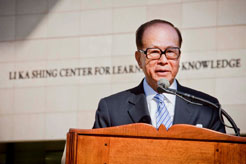 Download (1,046 KB) Li Ka-shing speaks at the dedication ceremony of the Li Ka Shing Center for Learning and Knowledge at Stanford University. The new center houses state-of-the-art medical training facilities and technology as well as the Dean's office for the Stanford University School of Medicine. |
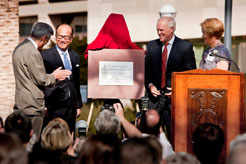 Download (1,371 KB) Li Ka-shing and University President John Hennessy unveil the dedicatory plaque of the Li Ka Shing Center for Learning and Knowledge while Dean Philip Pizzo of the Stanford University School of Medicine and Leslie P. Hume, Chair of the Board of Trustees, look on. |
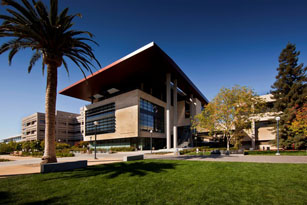 Download (2,179 KB) The Li Ka Shing Center for Learning and Knowledge was officially dedicated on September 29, 2010. |
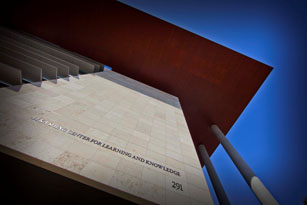 Download (1,099 KB) The Li Ka Shing Center for Learning and Knowledge serves as the new focal point of the Stanford University School of Medicine, as well as the center for student training, activities. |
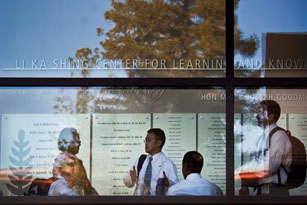 Download (1,583 KB) Visitors browse in the main lobby of the Li Ka Shing Center for Learning and Knowledge at the Stanford University School of Medicine in Palo Alto, California. |
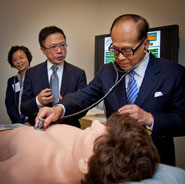 Download (1,324 KB) Li Ka-shing examines "Harvey", a cardiopulmonary patient simulator in the Li Ka Shing Center for Learning and Knowledge at the Stanford University School of Medicine. The new, five-story building is one of the most technologically advanced medical training centers in the world for immersive and simulation-based learning. |
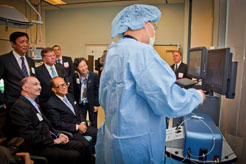 Download (1,367 KB) Li Ka-shing looks on as Dr Alan Yeung performs a simulated endovascular procedure in the new Li Ka Shing Center for Learning and Knowledge at the Stanford University School of Medicine. The technologically advanced building has one of the largest and most advanced simulation facilities in the world and a high-end video capture system, representing the latest in medical education. Dr Yeung also received the first Li Ka Shing Professorship in Cardiology. |
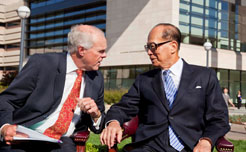 Download (1,691 KB) Li Ka-shing confers with President John Hennessy of Stanford University prior to the dedication of the Li Ka Shing Center for Learning and Knowledge at the school of medicine, September 29, 2010. |
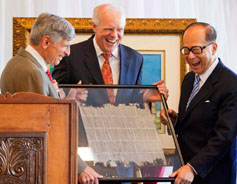 Download (2,938 KB) President John Hennessy of Stanford University and Dean Philip Pizzo of the medical school laugh with Li Ka-shing as he presents the school with an ancient Chinese crib sheet, used by students in the 18th and 19th centuries to cheat on imperial exams. The presentation was made during the dedication ceremonies of the new Li Ka Shing Center for Learning and Knowledge at the Stanford University School of Medicine. |
About Stanford University School of Medicine
The Stanford University School of Medicine consistently ranks among the nation's top medical schools, integrating research, medical education, patient care and community service. For more news about the school, please visit http://mednews.stanford.edu. The medical school is part of Stanford Medicine, which includes Stanford Hospital & Clinics and Lucile Packard Children's Hospital. For information about all three, please visit http://stanfordmedicine.org/about/news.html.
About the Li Ka Shing Foundation
The Li Ka Shing Foundation was established in 1980 by global entrepreneur and philanthropist Li Ka-shing. Mr Li considers the Foundation to be his "third son" and has pledged one-third of his assets to it. To date, the Foundation has granted over HK$11.3 billion (US$1.45 billion) in charitable donations, over 80 per cent of which has gone to the Greater China region.
The Foundation supports projects that propel social progress and create a cycle of charity in the world through expanding access to quality education and healthcare, encouraging cultural diversity and exploration, and stimulating community involvement and sustainable development. For more information, please visit www.lksf.org.
For media enquiries, please contact:
|
Ruthann Richter Stanford University School of Medicine Tel: (650) 725-8047 Fax: (650) 723-7172 Email: richter1@stanford.edu |
Jeremy Lau Li Ka Shing Foundation Tel: (852) 2128 1207 Fax: (852) 2128 1766 Email: jeremyl@hwl.com.hk |
1. You have been immensely supportive of education in general, but what was it about this particular project at Stanford that appealed you?
Stanford has always had a very special place in my heart. This is our third major project with the university, and each one reminds me of the time I brought my oldest son, Victor, to the campus to begin his education here many years ago. As we walked together past these beautiful buildings, I was overtaken by everything this university represents and the opportunities it provides for students. On that occasion, I remember looking at Victor and saying, "This is the first time in my life that I feel true envy of your good fortune." I genuinely yearned for the opportunity he was going to have, and I am grateful that he had such an experience. Concerning this center specifically, Stanford has a rich history as a leader in medical education and health care delivery, and I took interest in the proposed center for learning and knowledge when I heard about the innovative use of technologies to combine a multi-dimension and interdisciplinary learning opportunities, as well as cutting-edge virtual and experiential training, which I believe are all important cornerstone for the era of life sciences and biotechnology.
2. Your own education was cut short as a result of war in China. How did that affect your approach to education and your decision to invest so much in the field?
I have great respect for education. My father was an educator, and he was one of my heroes. That my own formal education was cut short due to war circumstances is one of the voids in my life that has never been adequately filled. It is the price we often pay during the unanticipated and uncontrollable turmoil in life, such as war. However, my lack of a formal education was also something of a blessing as it created a hunger for learning in me and compelled me to do everything in my power to read and listen and learn, as well as to use the blessings that have come into my life to benefit others in achieving their educational aspirations. You never know what the future holds, or how life's unexpected experiences can alter destinies. Had it not been for the war and my father's death, my desire in life was to remain in school and to become a physician. Perhaps this is also why I am so interested in supporting this new center.
3. How do you think this building will change the way medicine is practiced in the future?
This building opens a new era in medical education. Its innovation not only offers technologies of the future today to help train students and to provide virtual, experiential exercises for practitioners, but it will also encourage continued innovation, multi-dimensional and cross-disciplinary learning, as well as promote the highest quality of education in health care everywhere. With the excitement I feel, I can only imagine how wonderfully exciting it is to be a student here, with so many opportunities to embrace these new technologies and learn.
4. What are the values that shaped your life and that you hope will shape the lives of others who do their training here?
I believe that the ultimate meaning in life is to serve and help others reach their potential. I have tried to make this my life's work, and I hope that this new center for learning and knowledge will do the same and inspire other institutions to follow its lead.
5. What do you hope to see students do once they have completed their courses of study here?
My fondest hope is that they will build their careers through proper ways, and set serving others as their goals also.